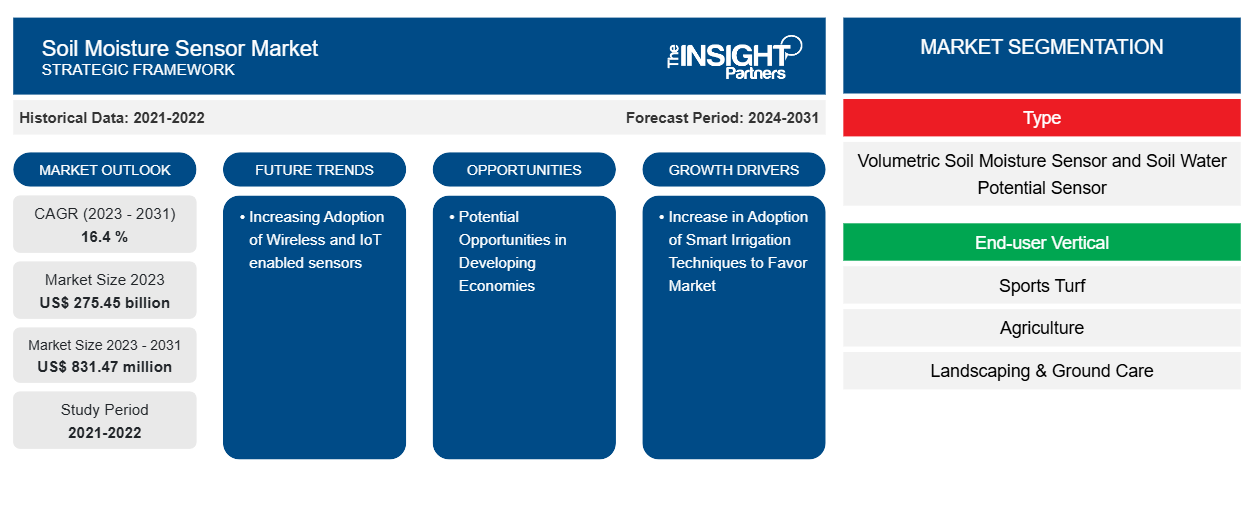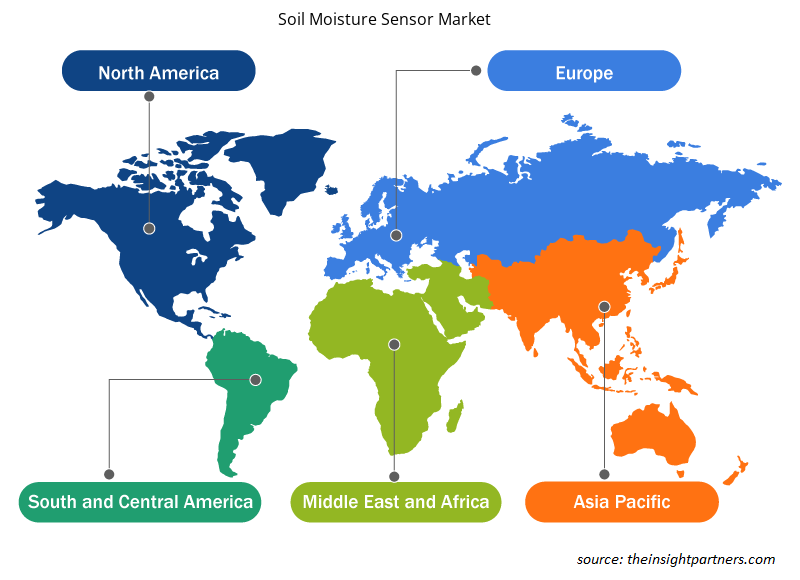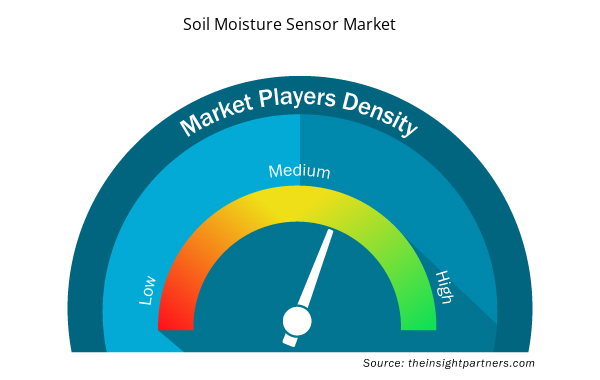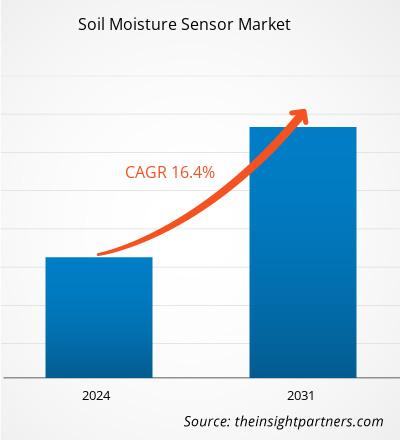The soil moisture sensor market size is projected to reach US$ 831.47 million by 2031 from US$ 275.45 billion in 2023. The market is expected to register a CAGR of 16.4 % in 2023—2031. The market for soil moisture sensors is heavily influenced by factors such as population growth, shortage of arable land, rising food prices, and advancements in agricultural technology.
Soil Moisture Sensor Market Analysis
Farmers understand the importance of managing resources sustainably. Both the environment and agriculture depend heavily on the quality of the soil. Determining the soil's moisture content in agriculture allows for the evaluation of crop production's feasibility and profitability. As a result, there is a growing need for soil moisture sensors throughout the world. Soil moisture sensors find widespread use in agricultural yield forecasts, bioremediation, landfill management, wastewater reclamation, irrigation control, and early drought warning systems.
Soil Moisture Sensor Market Overview
The water content of the soil is measured using soil moisture sensors. Soil moisture content can be measured using a variety of laboratory and field techniques, including remote sensing, although using soil moisture sensor devices is the most efficient and quickest method. Water agencies have long faced challenges in achieving consistent and measurable water savings through the implementation of water use efficiency programs. Programs designed to save landscapes have traditionally concentrated on teaching about scheduling irrigation, maintaining irrigation systems, and choosing plants that are suitable for the local environment. Even though these initiatives have resulted in savings, there is still a lot of room for improvement in landscape irrigation efficiency.
Customize This Report To Suit Your Requirement
You will get customization on any report - free of charge - including parts of this report, or country-level analysis, Excel Data pack, as well as avail great offers and discounts for start-ups & universities
Soil Moisture Sensor Market: Strategic Insights

- Get Top Key Market Trends of this report.This FREE sample will include data analysis, ranging from market trends to estimates and forecasts.
You will get customization on any report - free of charge - including parts of this report, or country-level analysis, Excel Data pack, as well as avail great offers and discounts for start-ups & universities
Soil Moisture Sensor Market: Strategic Insights

- Get Top Key Market Trends of this report.This FREE sample will include data analysis, ranging from market trends to estimates and forecasts.
Soil Moisture Sensor Market Drivers and Opportunities
Increase in Adoption of Smart Irrigation Techniques to Favor Market
One of the main problems that countries all over the world are currently facing is a lack of water. Approximately 60% of the freshwater reserves in the globe are thought to be consumed by agriculture, which is the primary user of water for agricultural irrigation. Therefore, a system is needed to effectively control the amount of water used in agriculture. Here, smart irrigation systems are essential because they apply more effective irrigation strategies that both lower water consumption and boost agricultural yield. Soil moisture sensors are useful for figuring out when, where, and how much water a crop needs at any given time. This information helps farmers produce more crops. Installing these sensors is simple, and.
Potential Opportunities in Developing Economies.
Food security is important, particularly in developing nations where environmental deterioration is a severe danger—Agriculture primary one of the prime sources of income in developing economies like China, India, and Brazil. To converge the demand for food production with the rapidly expanding population, these countries must effectively use the available land. The requirement for soil moisture sensors is anticipated to increase in these developing countries because the soil moisture content is important in determining crop production.
Soil Moisture Sensor Market Report Segmentation Analysis
Key segments that contributed to the derivation of the soil moisture sensor market analysis are types and end-user vertical.
- Based on type, the soil moisture sensor market is divided into volumetric soil moisture sensors and soil water potential sensors.
- By end-user vertical, the market is segmented into sports turf, agriculture, landscaping & ground care, forestry, and others.
Soil Moisture Sensor Market Share Analysis by Geography
The geographic scope of the soil moisture sensor market report is mainly divided into five regions: North America, Asia Pacific, Europe, Middle East & Africa, and South America/South & Central America. North America has dominated the soil moisture sensor market. High technology adoption trends in various industries in the North American region have fuelled the growth of the soil moisture sensor market. Factors such as increased adoption of digital tools and high technological spending by government agencies are expected to drive the North American soil moisture sensor market growth. Moreover, a strong emphasis on research and development in the developed economies of the US and Canada is forcing the North American players to bring technologically advanced solutions into the market. In addition, the US has a large number of Soil Moisture Sensor market players who have been increasingly focusing on developing innovative solutions. All these factors contribute to the region's growth of the soil moisture sensor market.
Soil Moisture Sensor Market Regional Insights
The regional trends and factors influencing the Soil Moisture Sensor Market throughout the forecast period have been thoroughly explained by the analysts at Insight Partners. This section also discusses Soil Moisture Sensor Market segments and geography across North America, Europe, Asia Pacific, Middle East and Africa, and South and Central America.

- Get the Regional Specific Data for Soil Moisture Sensor Market
Soil Moisture Sensor Market Report Scope
| Report Attribute | Details |
|---|---|
| Market size in 2023 | US$ 275.45 billion |
| Market Size by 2031 | US$ 831.47 million |
| Global CAGR (2023 - 2031) | 16.4 % |
| Historical Data | 2021-2022 |
| Forecast period | 2024-2031 |
| Segments Covered |
By Type
|
| Regions and Countries Covered | North America
|
| Market leaders and key company profiles |
Soil Moisture Sensor Market Players Density: Understanding Its Impact on Business Dynamics
The Soil Moisture Sensor Market is growing rapidly, driven by increasing end-user demand due to factors such as evolving consumer preferences, technological advancements, and greater awareness of the product's benefits. As demand rises, businesses are expanding their offerings, innovating to meet consumer needs, and capitalizing on emerging trends, which further fuels market growth.
Market players density refers to the distribution of firms or companies operating within a particular market or industry. It indicates how many competitors (market players) are present in a given market space relative to its size or total market value.
Major Companies operating in the Soil Moisture Sensor Market are:
- Sentek Technologies
- Irrometer Company, Inc.
- Delta-T Devices Ltd
- Stevens Water Monitoring Systems Inc.
- The Toro Company
- Acclima, Inc.
Disclaimer: The companies listed above are not ranked in any particular order.

- Get the Soil Moisture Sensor Market top key players overview
Soil Moisture Sensor Market News and Recent Developments
The Soil Moisture Sensor market is evaluated by gathering qualitative and quantitative data post primary and secondary research, which includes important corporate publications, association data, and databases. The following is a list of developments in the market:
- In January 2023, - CropX Technologies, one of the global leaders in digital solutions for agronomic farm management, announced its acquisition of Tule Technologies, a precision irrigation company based in California. This acquisition brings new data capture technologies to the CropX Agronomic Farm Management System and expands its market in California drip-irrigated specialty crops.
(Source: CropX Technologies, Press Release, 2023)
- In October 2022, Sensoterra launched a new generation of single-depth sensors with a new antenna design. The newly launched sensor has improved the LoRaWAN signal strength by 2 to 4 factors and offers better durability along with increased accuracy.
(Source: Sensoterra, Press Release, 2022)
Soil Moisture Sensor Market Report Coverage and Deliverables
The "Soil Moisture Sensor Market Size and Forecast (2021–2031)" report provides a detailed analysis of the market covering below areas:
- Market size and forecast at global, regional, and country levels for all the key market segments covered under the scope
- Market dynamics such as drivers, restraints, and key opportunities
- Key future trends
- Detailed PEST/Porter's Five Forces and SWOT analysis
- Global and regional market analysis covering key market trends, major players, regulations, and recent market developments
- Industry landscape and competition analysis covering market concentration, heat map analysis, prominent players, and recent developments
- Detailed company profiles
- Historical Analysis (2 Years), Base Year, Forecast (7 Years) with CAGR
- PEST and SWOT Analysis
- Market Size Value / Volume - Global, Regional, Country
- Industry and Competitive Landscape
- Excel Dataset



Report Coverage
Revenue forecast, Company Analysis, Industry landscape, Growth factors, and Trends

Segment Covered
Type , and End-user Vertical

Regional Scope
North America, Europe, Asia Pacific, Middle East & Africa, South & Central America

Country Scope
US, Canada, Mexico, UK, Germany, Spain, Italy, France, India, China, Japan, South Korea, Australia, UAE, Saudi Arabia, South Africa, Brazil, Argentina
Frequently Asked Questions
What is the estimated market size for the global soil moisture sensor market in 2023?
The global soil moisture sensor market was estimated to be US$ 275.45 million in 2023 and is expected to grow at a CAGR of 16.4% during the forecast period 2024 - 2031.
What are the driving factors impacting the global soil moisture sensor market?
The increase in the adoption of smart irrigation techniques is the major factors that propel the global soil moisture sensor market growth.
What are the future trends of the global soil moisture sensor market?
Opportunities in developing economies are impacting the soil moisture sensor, which is anticipated to play a significant role in the global soil moisture sensor market in the coming years.
Which are the key players holding the major market share of the soil moisture sensor market?
The key players holding majority shares in the global soil moisture sensor market are Sentek Technologies; Irrometer Company, Inc.; Delta-T Devices Ltd; and Stevens Water Monitoring Systems Inc.; The Toro Company; Acclima, Inc.; Decagon Devices, Inc.; Campbell Scientific, Inc.; IMKO Micromodultechnik GmbH; Spiio, Inc.
What will be the market size of the global soil moisture sensor market by 2031?
The global soil moisture sensor market is expected to reach US$ 831.47 million by 2031

 Get Free Sample For
Get Free Sample For